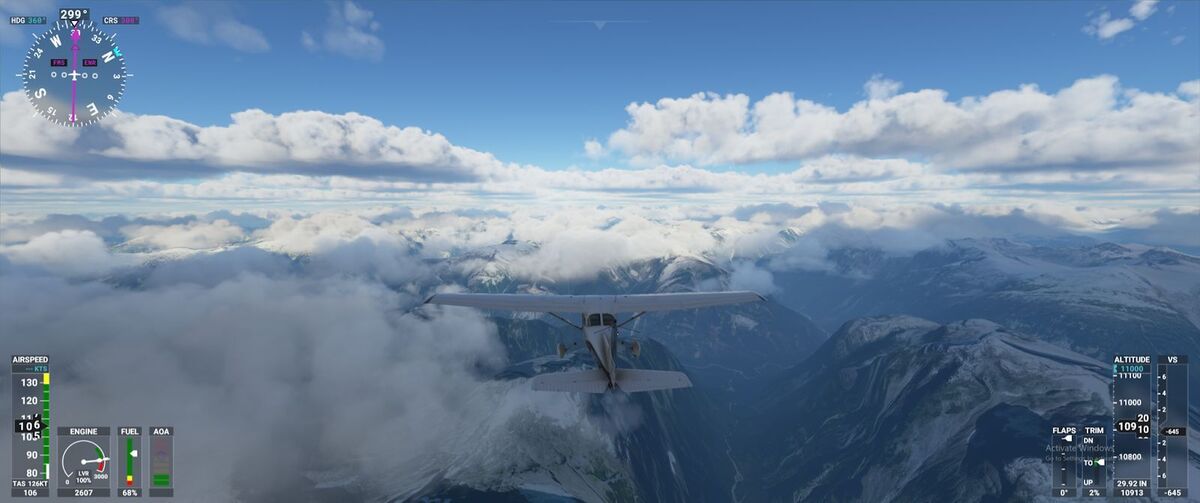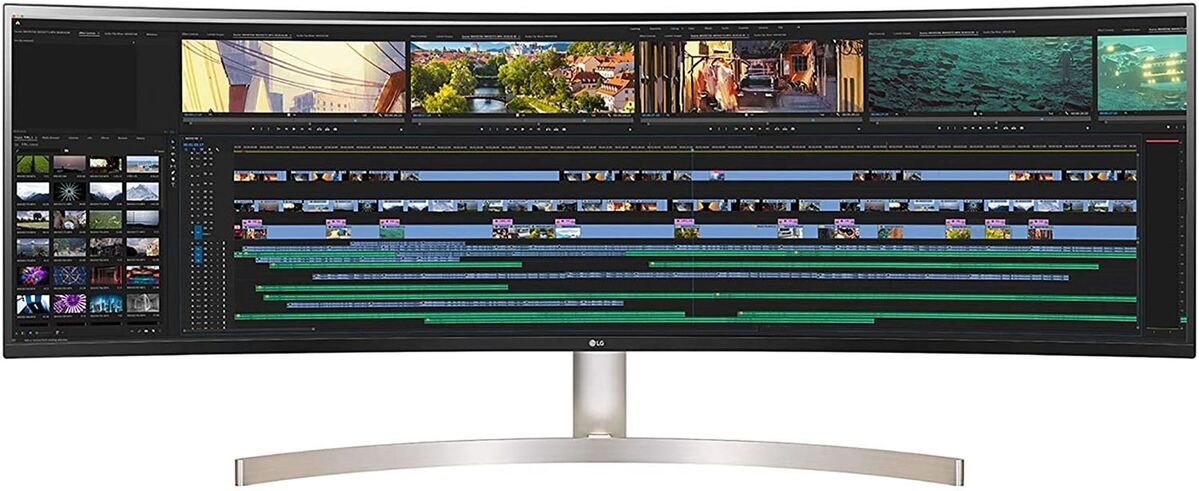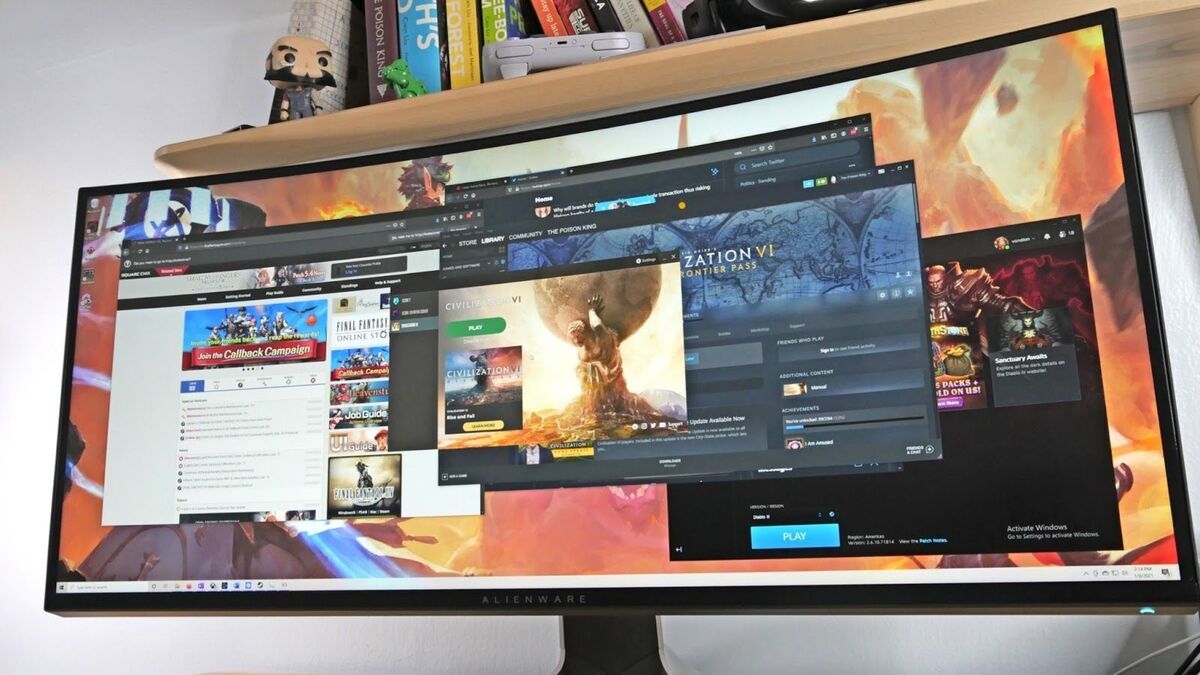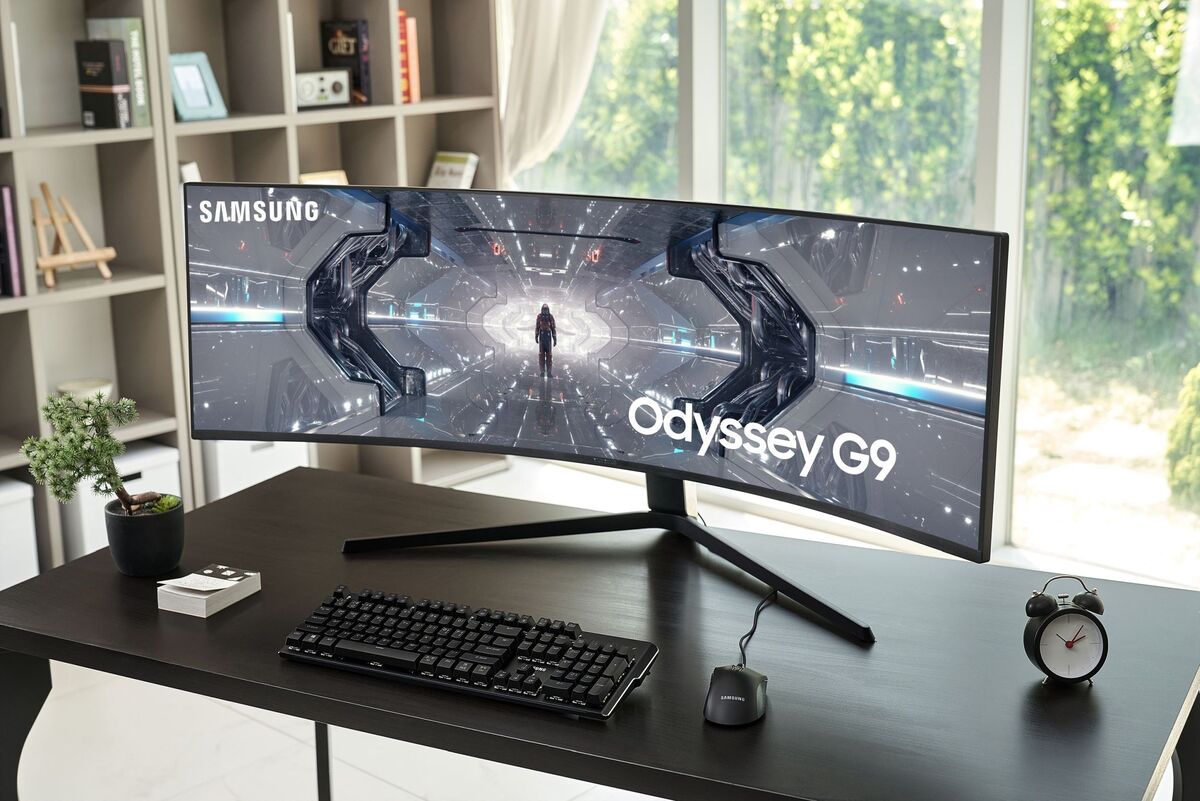Buying an ultrawide monitor for your PC is the most dramatic choice you can make short of purchasing a full-sized HDTV and slapping it on your desktop. Ultrawides are massive monitors that will dominate your desk and may even require a re-think of your existing office or gaming setup. They’ll also empty your wallet, with even mid-range ultrawides starting around $500. Yet there’s good reason to make an ultrawide your next monitor.
Yes! An ultrawide monitor is worth it.
If you just want a quick recommendation, here it is: yes! Buy an ultrawide monitor. An ultrawide monitor makes multitasking more comfortable and enhances your gaming experience with an immersive field of view.
Most people should focus on buying a 34-inch ultrawide monitor with a resolution of 3,440 x 1,440. If you want to game, look for an enhanced refresh rate (120Hz or better) and support for an adaptive sync standard compatible with your graphics card. This describes most ultrawide monitors sold today, so you’ll be spoiled for choice.
Now to go more in-depth.
An ultrawide monitor is an awesome upgrade for most PC games
Aspect ratio is the killer feature of every ultrawide monitor, no matter its size or resolution. Every ultrawide has a 21:9 aspect ratio, and some go even wider. This is wider than the 16:9 aspect ratio of most monitors and HDTVs. The result? You literally see more game than on a 16:9 monitor.
I’ll say this again, because it’s important: the 21:9 aspect ratio is the killer feature, and it has nothing to do with size or resolution.
Gamers considering an ultrawide monitor often ponder buying an HDTV instead. You can snag a nice 55-inch HDTV for the price of most 34-inch ultrawide monitors. That seems like a better value, but it’s often not.
Why? Because a larger display doesn’t always provide a more immersive experience. The in-game perspective remains tied to a 16:9 aspect ratio. What you see will appear larger, but that’s all. Your in-game perspective will be identical on a 24-inch, 32-inch, 55-inch, or 85-inch 16:9 display.
An ultrawide, with its 21:9 aspect ratio, offers a broader perspective. You‘ll see more to the left and right than on a 16:9 monitor or television. This is great in games that focus on an immersive experience or benefit from seeing as much information as possible.
 Matt Smith/IDG
Matt Smith/IDG
Microsoft Flight Simulator is breathtaking on an ultrawide monitor.
Microsoft Flight Simulator is simply better on an ultrawide display. Your field of view is constrained on a 16:9 monitor or television. You’ll have difficulty viewing a plane’s entire cockpit and be forced to move your camera frequently. Driving games like Forza 7 and American Truck Simulator are better on an ultrawide for the same reasons.
An ultrawide’s extra space can also be used to serve more information. Strategy games like Civilization VI will offer a wider view of the game map, letting you see more of the world at once without zooming out. Massively multiplayer games like World of Warcraft and Final Fantasy XIV also benefit. They’ll appear less cluttered because you have more space to customize the interface.
Ultrawide monitors fall short in competitive and console games
It’s not all good news for gamers. Ultrawides are less suited to specific genres that don’t benefit from the extra width.
Competitive esports games are one example. Ultrawides remain controversial in this arena because a wider field of view can be a competitive advantage. Player complaints have forced most competitive games to support ultrawide monitors, but support may come with problems like an odd perspective or an unwieldy interface. Gamers serious about going pro should stick with 16:9, as professional competitive scenes rarely let players use an ultrawide monitor.
Console gamers will also be disappointed, as modern consoles like the PlayStation 5, Xbox Series X/S, and Nintendo Switch don’t support the 21:9 aspect ratio. This is true even for cross-platform games that support ultrawide monitors on the PC.
You can connect a game console to an ultrawide monitor, but you will see large vertical letterboxes on each side of the screen. You may be able to eliminate them in an ultrawide monitor’s settings by zooming the image, but the result will look strange.
If you do want to use an ultrawide monitor with a console, look for an ultrawide that has a split-screen mode with multiple inputs. This will let you split the 21:9 screen into a 16:9 screen (connected to your console) and a 5:9 screen (connected to a PC). That’s useful for looking up a game guide or viewing a Twitch stream while playing.
An ultrawide monitor can make you a multitasking hero
The extra width of an ultrawide isn’t just for games. It’s great for day-to-day work juggling a variety of windows and applications.
A typical 34-inch ultrawide monitor has a resolution of 3,440 x 1,440. Compare this to a typical 27-inch office monitor with a resolution of 2,560 x 1,440. You gain 880 pixels horizontally, which adds up to about 1.3 million additional pixels overall.
That’s a lot of extra space. You can use it to reference emails, documents, messaging apps, websites, and other information without reducing the size of the app you’re focused on. It’s also perfect for using two (or more) windows side-by-side. You can compare documents, edit two photos of a subject from different perspectives, or view a preview of a website or program while editing code in another window.
And an ultrawide monitor is great for audio and video editing
An ultrawide monitor’s extra space is on the horizontal axis. This is useful for multitasking, but also an advantage in editing apps that use a timeline.
 LG
LG
The 49-inch LG 49WL95C-W is even wider than most ultrawides, with a whopping 32:9 aspect ratio.
A timeline is typically laid out horizontally along the lower half of an app and shows an audio or video’s progress from beginning to end. An ultrawide’s extra space can be used to display more of the timeline at once. This helps you track what’s happening in a large project and reduces the need to scroll back and forth while editing.
The extra space also adds room for a preview of your project and increases the size of your workspace for browsing related files. Compared to a 16:9 monitor, you’ll be able to see more files at once and have a slightly larger preview.
There are downsides for video, however. Most video content is created in a 16:9 aspect ratio, not 21:9, so you won’t make the most of the ultrawide when it comes time to preview your project. Most ultrawide monitors can’t offer a 4K preview at the 16:9 aspect ratio, either, which is a problem if you’re working with 4K content.
But ultrawide is a trade-off for writers, programmers, and artists
Ultrawide monitors add pixels on the horizontal axis but are the same as a comparable 16:9 monitor on the vertical axis. This isn’t great for writers, editors, programmers, and photographers. Documents scroll vertically, so more horizontal space isn’t helpful. Programmers also typically use an interface that scrolls vertically to code, so again, the extra width is not that useful.
Photographers and digital artists often work in portrait orientation, which is an awkward fit for a wide display. The extra space of a 34-inch ultrawide relative to a 27-inch widescreen monitor becomes all but irrelevant when a photo or image is taller than it is wide.
An ultrawide will still help with multitasking, though. A programmer might like having extra horizontal space if that means having more workspace to browse related files, and a writer might like having more room to reference research.
Ultrawide monitors are huge, for better and for worse
The benefits of ultrawide monitors all come back to the aspect ratio’s extra width. Ultrawide monitors provide more usable space in games and productivity apps because, well, they’re big!
Ultrawide monitors often come with large stands that will take up a lot of space on your desk. You might feel cramped if you have large gaming peripherals or often use your desk for tasks that don’t involve your PC.
 Matt Smith/IDG
Matt Smith/IDGA 34-inch ultrawide monitor will sit closer to you than a 27-inch monitor when the display is pushed to the far edge of your desk. This is a problem if your desk is a bit narrow, as a monitor that’s too close can cause eye strain and force you to move your gaze frequently to see the entire screen.
38-inch ultrawide monitors are even worse about this: most won’t fit well on a desk 30 inches deep. You’ll need a deeper desk or a monitor arm to position a large ultrawide monitor at a comfortable distance.
Movies, television, and video is a mixed experience
Television manufacturers like Philips and Vizio tried to bring ultrawide to television with a line of “Cinema” televisions that appeared from 2010 to 2013. Most movies are filmed in a wide aspect ratio, so an ultrawide makes sense if you spend all your time watching movies. The horizontal bars across the top and bottom are smaller on an ultrawide, or gone entirely, since the display’s aspect ratio closer to that of the film.
Ultrawide TVs were discontinued after a few years, no doubt because most televisions spend most their time displaying 16:9 content. Video has skewed further towards narrow aspect ratios since then. Streaming services like Netflix and Hulu produce a ton of original content and favor the 16:9 aspect ratio. YouTube and Twitch content creators almost universally create content for the 16:9 aspect ratio.
Vertical video, popularized by smartphone-driven video experiences like TikTok and YouTube Shorts, is becoming more common. This doesn’t look great on a 16:9 display and makes even less sense on a 21:9 ultrawide. A 9:16 vertical video on a 21:9 ultrawide monitor will take up just 40 percent of the display’s horizontal space.
Still, you aren’t losing anything by viewing a 16:9 video or 9:16 video on a 21:9 display. You will see everything you would on a widescreen, but with large vertical letterboxing on each side.
Bottom line: An ultrawide is worth it
There’s a lot to consider when buying an ultrawide monitor, but the recommendation remains clear: yes, you should buy an ultrawide monitor.
 Samsung
SamsungThis isn’t just because the advantages outweigh the disadvantages. It’s because the flexibility of a PC suits the unusual width and resolution of an ultrawide display. Most devices, from smartphones to tablets and game consoles, are built for a very specific range of aspect ratios and resolutions. But not the PC! A computer running Windows 10 can handle anything from an 800 x 600 CRT to an 8K flat screen TV.
An ultrawide can take advantage of that flexibility. Most games and apps can use an ultrawide monitor’s strengths without issue or even additional configuration. The result is a larger, wider display that can show more content at once. That’s why an ultrawide is the best choice for most PC enthusiasts.





